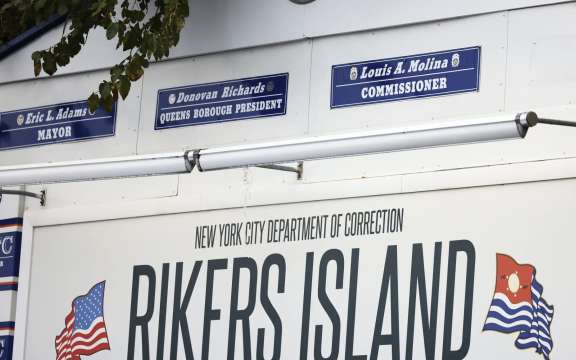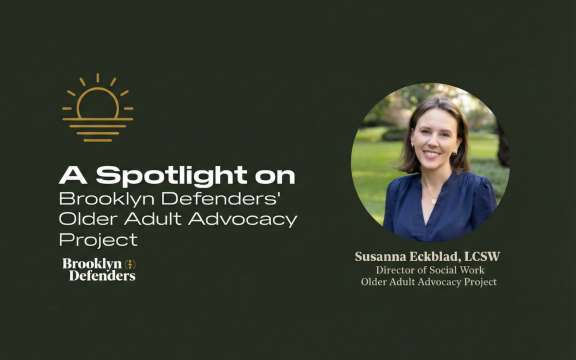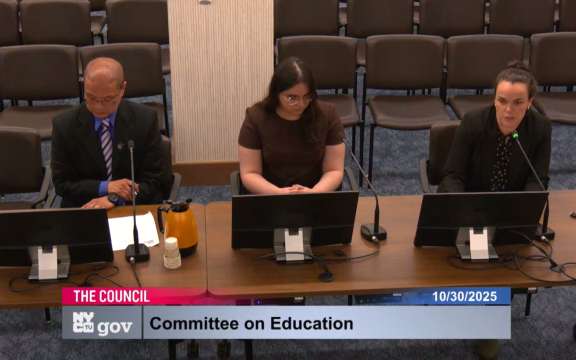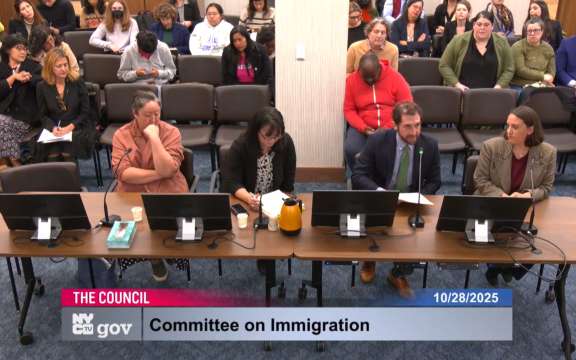BDS Testimony before New York State Assembly Standing Committee on Children and Families Regarding Legislative Change in the Family Regulation System
TESTIMONY OF:
Nila Natarajan
Supervising Attorney & Policy Counsel, Family Defense Practice
BROOKLYN DEFENDER SERVICES
Presented before The New York State
Assembly Standing Committee on Children and Families
October 21, 2021
On behalf of Brooklyn Defender Services (BDS), we would like to thank the New York State Assembly Standing Committee on Children and Families for holding today’s important hearing on the state’s family regulation system1 and for considering legislation that addresses the system’s harmful impact on communities of color and low-income families.
BDS provides multi-disciplinary and client-centered criminal defense, family defense, immigration, civil legal services, social work support and advocacy in nearly 30,000 cases involving Brooklyn residents every year. Our Family Defense Practice (“FDP”) is the primary provider of legal representation for parents in child abuse and neglect cases in Brooklyn. In fourteen years of service, FDP has represented almost 14,000 parents and caretakers in Brooklyn Family Court and impacted the lives of over 30,000 children. We currently represent over 2,300 parents and caretakers. Our community office is located in the East New York neighborhood of Brooklyn which has one of the highest rates of ACS investigations and surveillance in the city.
The ongoing COVID-19 pandemic of the past 19 months has helped lay bare the profound inequities in our state and country that have deepened the disparities in healthcare, employment, and housing and made marginalized communities more vulnerable to being targeted by systems.2 At the same time, as a nation we are also experiencing a long over-due public reckoning of systemic racism and the violent impact of policing and surveillance that fails to be accountable to the most-harmed communities. In this moment, this Committee has a unique opportunity to interrogate existing structures, such as the family regulation system, that have historically targeted communities of color. The legislature can make bold legislative changes that hold this system accountable and ensure that families receive the support and resources, not surveillance, that are needed to keep families together and to thrive.
Like the criminal legal system, race and poverty are defining characteristics of the family regulation system. Poor communities and communities of color are disproportionately impacted by the state’s family regulation system. In New York, Black children make up 40% of the children in foster care yet make up only 15% of the children in the state, whereas white children make up 25% of the children in foster care and 48% of the children across the state.3 Black children also fare far worse in the foster care system and have much longer stays in care.4
Most of the people we represent are people of color living in poverty, raising their children in homeless shelters or public housing, and in highly policed neighborhoods, making them vulnerable to government surveillance. Similar to the ways in which the criminal legal system was exposed for using pretext to “stop-and-frisk” a person based on their race or the neighborhood they live in, an initial investigation can lead to further invasive involvement by the family regulation system, including surveillance of a family, and even the removal of children from their home.5 This type of pretextual surveillance and punishment within the family regulation system may apply to a range of behaviors or indicators of poverty that are stigmatized and “othered.6” Families living in homeless shelters, under incredible economic stress, are living under the fear that one argument between parents or one moment of impatience with a child may lead to a knock on their door from a child welfare worker. School attendance interrupted by homelessness, or an angry landlord seeking to evict a family illegally can result in a call to the family regulation authorities and begin an investigation into a family.
While poverty may be an indicator of the likelihood of family regulation system involvement for a child, family, or communities7 - it is not because poverty leads to neglect, but because the lack of resources to care for child can be confused for maltreatment, the lack of resources for parents can leave families unsupported in crises, and the intense stress of unstable housing and income can make already vulnerable families easily susceptible to system involvement.8 Given the systemic racism engrained in the family regulation system, and the accompanying distrust of a punitive and surveillance-oriented approach, the family regulation system is ill-equipped to support families.9 Yet studies are clear that providing real economic resources to families corresponds with a reduction in family regulation system involvement.10
Further, while our clients usually have many needs that impact their ability to provide and care for their families, most of these families we serve suffer more trauma from being separated than from staying together with access to greater resources. For families of color subject to ACS investigations, the risk of separation is far greater than for white families. In New York City, Black and Latinx/Hispanic/Latino/a/é children are 13 times more likely than a white child to be placed in the foster system. 11 Outside of New York City, Black and Latinx/Hispanic/Latino/a/é children are 5 times more likely to be placed in the foster system as compared to white children.12 For parents struggling with mental health issues, cognitive delays or addiction, the system is often a punitive one, rather than a restorative and supportive one that leads a family to long-term stability and safety.
There are hundreds of studies that detail the long-term harmful impact on children when they are separated from a parent.13 In the wake of the outrage about the federal government’s mandatory detention and family separation policy at the border under President Trump, many observers rightly noted that the federal government’s policy had ample precedent in the laws and practices of our family regulation system. The removal of children often occurs without serious regard for family unity or well-being, and child removals, though purportedly intended to protect children from abuse or mistreatment, often do more harm than good. As told by one expert, when a young child is separated from a parent for a long period of time, “they remain on high alert, and their bodies endure prolonged and severe toxic stress as a result. That interrupts the brain’s architecture at a critical time of development, when neural circuits — the pathways necessary to carry information to and from the brain — are forming rapidly, at a rate of more than 1 million neural connections each second in infants and toddlers. Stress hormones block those neurons. This can lead to delayed development in reason, learning and emotional development… If continuously exposed to toxic stress over time, damage done to the child’s brain cannot be changed, studies have shown”.14
We need a drastic shift in public opinion about New York’s family regulation system, as we have started to do with the criminal legal system. Public hearings like this one today offer a critical opportunity to shine a light on the state’s system and the laws and policies that have stymied real change that lead to greater access to supports and resources for families, and that reduce the punitive and violent impact of the family regulation system.
Legislative Change is Needed to Strengthen Protect New York Families and Address the Harms of the Family Regulation System
1. Family Miranda Rights Act (S.5484/A.6792): Ensuring New York Families Know Their Rights During an Investigation
Parents and caretakers must be aware of their rights during a child welfare investigation so that they can make informed decisions about their family. These investigations are serious government invasions of families’ privacy and may infringe on their right to family integrity, resulting in the parents’ loss of the care and custody of their own children. Connecticut’s legislature paved the way for informing parents of their rights in 2011 by enacting a comprehensive parent’s bill of rights statute15 that could serve as a model to help New York parents understand and protect their rights when it comes to their children.
In our practice, we regularly meet with parents who have been dealing with New York City’s Administration for Children’s Services for weeks or months without the benefit of counsel or information about their rights. They are often subjected to drug and alcohol testing without informed consent; their mental health and medical providers are contacted without informed consent; and their children are interviewed at all hours of the day and night—including while they are at school—without their parents’ permission.16
Passing the Family Miranda Rights Act would ensure that all New Yorkers, regardless of income, county, or neighborhood, understand their rights during a children welfare investigation so all parents can make informed decisions for their family. This legislation does not create new rights and does not hinder the government’s authority to immediately intervene in an emergency – but instead ensures that all parents know their rights and are able to make the best and most-informed decisions about their families.
The Family Miranda Rights Act requires that all investigative child welfare workers be charged with providing the notice of rights upon initial contact with a family both orally and in writing. This legislation enumerates the specific rights every parent and caretaker has during a child welfare investigation, including that they are entitled to seek the advice or representation of counsel to help navigate an investigation, that they have the right to not allow the investigative worker into their home without a court order, that they have the right to refuse to submit to drug or alcohol screenings, and that they have the right to not sign releases for information or medical records. Importantly, this legislation requires that this notice must be provided to parents and caretakers in their first language and should be in plain language that considers the need for parents of all educational backgrounds and intellectual abilities to be able to read and understand the information being provided to them.
2. Anti-Harassment in Reporting Bill (S.7326/A.7879): Creating a Confidential and Accountable Reporting System
New York State’s Central Register of Child Abuse and Maltreatment is flooded with anonymous reports of abuse and neglect. And while state law requires local child protective services to conduct an extensive investigation of every allegation of child abuse or neglect, whether there is any evidence for the claim, these anonymous calls are extremely unreliable. Astoundingly, of parents investigated because of an anonymous report, over 86% are cleared of all wrongdoing after an initial investigation, and even more are ultimately cleared after challenging the accusations in court or an administrative hearing.17
Most people who call the state hotline to report suspected abuse or neglect are mandated reporters, who are required to give their name and contact information.18 Yet non-mandated reporters, such as neighbors, family, or friends, who call the hotline are not required to give their name or any contact information – leading to these anonymous reports. Because of the requirement to investigate these reports, anonymous individuals can use the system to harass others repeatedly and without reprisal. Bad actors have taken advantage of this loophole. Empirical evidence demonstrates anonymity fosters harassing behavior.19 Abusive partners, angry exes, unscrupulous landlords, and feuding neighbors use anonymous reporting to call in false allegations against parents. 20 Domestic violence survivors in particular report that abusers routinely use the anonymous reporting system to harass their former partners and their children.21
Each year, more than 10,000 New York families are forced to endure lengthy, invasive, and stressful investigations because of an anonymous report before they are eventually cleared.22 These investigations can be harmful to children and have serious long-term consequences for families.23 Investigations last for months and are often extremely invasive. The process is stressful to parents, who have their homes searched, are subjected to repeated surprise visits, are expected to miss work for investigatory meetings, and may face the loss of their jobs or stigmatization by their communities. The disruption can be even more traumatic to children, who often are woken in the middle of the night, questioned by investigators, and sometimes strip searched. Throughout the process, parents and children live in fear that they might be torn apart. Families who have endured these investigations report that the psychological and financial consequences persist long after the case is closed.
The Anti-Harassment in Reporting Bill offers a simple solution to drastically reduce the number of malicious false calls: require that every caller confidentially provide their name and contact information when making a report to the hotline. This information would be kept confidential from the public and from the person accused of abuse or neglect, while allowing child welfare investigators to conduct a full and more reliable investigation. This common-sense fix will protect callers’ privacy by preserving the confidentiality of those making reports while discouraging intentionally false reports. It will help shield families from unjustified investigations and improve the accuracy, efficiency, and integrity of child welfare investigations.
3. Informed Consent Bill (S.4821/A.4285): Protecting the Rights of Patients and Strengthening Access to Treatment
Racial disparities have been well-documented at many points in the health care delivery system, and we know that parents of color and poor parents are more likely to be drug-tested in child birth than white parents, more likely to be reported to the family regulation system, and more likely to be investigated by the state.24 Positive drug tests often lead to further invasive investigation, the filing of a family court case, and possibly the removal of children. Even after marijuana use and possession was legalized in New York State, our office continues to represent clients who face neglect allegations and the removal of their children due to their marijuana use during, before and even after pregnancy.
Many of the people we represent utilize public and private hospitals that predominately serve low- income patients for prenatal care, labor, and delivery. It is common for our clients and their newborns to be drug-tested at birth, often without their knowledge, without their informed consent, or even despite their explicit refusal. New York City’s Health + Hospitals’ (H+H) policy requires verbal consent to drug testing during or after labor, but many people who have been tested at a hospital report that they were never asked permission for the hospital to test themselves or their babies. Drug testing without informed consent is often applied selectively, disproportionately impacting poor women and women of color using government-funded health care,25 and is out of step with professional standards. 26 This is particularly disturbing because in our experience hospitals are not using confirmatory testing or the most reliable testing,27 and there are no drug testing guidelines or requirements for hospitals, as there are in other contexts.
Given the dearth of scientific evidence proving that a person’s use of marijuana during pregnancy is harmful to a child,28 particularly when that child has not also tested positive for marijuana, the choice to test a person for marijuana during labor is in and of itself unnecessarily invasive and may only lead to worse outcomes for the family. As far as we know, there is no standard of care that is different for a newborn who tests positive for marijuana, and a mother’s positive test for marijuana does not provide any useful information about a new parent’s current ability to care for a newborn.29 On the contrary, the heightened scrutiny and separation of infants from their mothers after birth that occurs when a mother or child tests positive for marijuana at birth have clear negative consequences to neonatal development.30 Evidence also shows that routinely testing pregnant mothers and newborns is bad public health policy. It may cause women to avoid seeking prenatal care or other treatment because of a fear that their newborns will be removed. As such, there is no clear medical or child protective justification for testing birthing parents for marijuana.
***
As it stands, the family regulation system is disproportionately harmful to communities of color and low-income families. Through these three vital pieces of legislation, the Assembly, through this Committee, has the ability to shrink the negative impact of this system and support safe and strong families.
BDS is grateful to the Assembly Standing Committee on Children and Families for hosting this critical hearing and shining a spotlight on these issues within the state’s family regulation system. Thank you for your time and consideration of our comments. We look forward to further discussing these and other issues that impact people we represent. Thank you for considering BDS’ comments and recommendations. If you have any additional questions, please contact Nila Natarajan at nnatarajan@bds.org or 347-592-2504.
1 Many, including scholar Professor Dorothy Roberts, have come to refer to the “child welfare” system as the family regulation system, given the historical and current harms perpetuated by the system. See e.g., Dorothy Roberts, “Abolishing Policing Also Means Abolishing Family Regulation”, The Imprint (June 16, 2020), found at: https://imprintnews.org/child-welfare-2/abolishing-policing-also-means-abolishing-family-regulation/44480.
2 Villarosa, Linda (April 29, 2020) “A Terrible Price: The Deadly Racial Disparities of Covid-19 in America”; New York Times; Mays, Jeffrey C. Andy Newman. (2020 April 8). “Virus is Twice as Deadly for Black and Latino People Than Whites in N.Y.C” New York Times.
3 https://ocfs.ny.gov/main/reports/maps/counties/New%20York%20State.pdf, page 7.
4 https://www.gao.gov/new.items/d07816.pdf, page 4.
5 Burrell, Michelle. “Child Welfare Needs to Have It’s ‘Stop-And-Frisk Moment.’ The New School Center for New York City Affairs. http://www.centernyc.org/child-welfare-needs-to-have-its. June 27, 2018.
6 https://imprintnews.org/child-welfare-2/time-for-child-welfare-system-to-stop-confusing-poverty-with- neglect/40222
7 https://scaany.org/wp-content/uploads/2018/12/Improving-NY-Child-Welfare-Outcomes-by-Strengthening-Fam- Econ-Sec-Dec.-2018.pdf, at 6.
8 See id at 6-7.
9 See id at 7-8.
10 See Kerri M. Raissian & Lindsey Rose Bullinger, Money Matters: Does The Minimum Wage Affect Child Maltreatment Rates?, 72 CHILD.&YOUTH SERVS.REV.60, 63–66 (2016); see also Nicole L. Kovski et al., Association of State-Level Earned Income Tax Credits WithRates of Reported Child Maltreatment, 2004–2017, 20 J.CHILD MALTREATMENT1, 1 (2021).
11https://ocfs.ny.gov/main/bcm/DMR_Section%20Seven%20of%20Grant%20RFP_2015.pdf, page 7.
12 See id.
13 https://www.pbs.org/newshour/health/how-the-toxic-stress-of-family-separation-can-harm-a-child
14 See id.
15 C.G.S.A. § 17a-103d
16 Rise, Surveillance Isn’t Safety- How over-reporting and CPS Monitoring Stress Families and Weaken Communities(Sept. 17 2019).
17 Children’s Bureau, Admin. for Children & Families, U.S. Dep’t of Health & Human Servs., National Child Abuse and Neglect Data System Child File (2019) [hereinafter NCANDS Child File], https://www.ndacan.acf.hhs.gov/datasets/dataset-details.cfm?ID=237 (The data used in this publication were made available by the National Data Archive on Child Abuse and Neglect, Cornell University, Ithaca, NY, and have been used with permission. Data from the National Child Abuse and Neglect Data System were originally collected by the Children’s Bureau. The collector of the original data, the funder of this project, NDACAN, Cornell University and their agents or employees bear no responsibility for the analyses or interpretations presented here.); Nikita Stewart, The Child Abuse Charge Was Dismissed. But It Can Still Cost You a Job., NY. TIMES (Feb. 25, 2019), https://www.nytimes.com/2019/02/25/nyregion/ny-child-abuse-database.html.
18 NCANDS Child File, supra note 1; N.Y. SOC. SERV. LAW § 413(1)(b) (“Any report shall include the name, title and contact information for every staff person of the institution who is believed to have direct knowledge of the allegations in the report.”)
19 See, e.g., Christopher P. Bartlett, Anonymously Hurting Others Online: The Effect of Anonymity on Cyberbullying Frequency, 4 PSYCHOL. OF POPULAR MEDIA CULTURE 70 (2015) (study found anonymity was a “strong predictor” of cyberbullying and harassing behavior); Michael J. Moore et al., Anonymity and Roles Associated with Aggressive Posts in an Online Forum, 28 COMPUTERS IN HUM. BEHAV. 861 (2012) (study found anonymity was associated with aggressive messages).
20 See, e.g., Rachel Blustain, False Abuse Reports Trouble Child Welfare Advocates, CITY LIMITS (Oct. 4, 2013), https:="" citylimits.org="" 2013="" 10...<="" a>child-welfare-advocates="" #.vbvxp2nng40"="">https://citylimits.org/2013/10... (discussing the prevalence of false reports against domestic violence victims and in low-income neighborhoods and communities of color); Andres O’Hara, Shaun King Says Anonymous Troll Has “Weaponized” NYC Dept. of Child Services Against Him, GOTHAMIST (Aug. 2, 2018), https://gothamist.com/news/shaun-king-says-anonymous-troll-has-weaponized- nyc-dept-of-child-services-against-him (discussing a series of malicious false reports filed anonymously against Black community leader and his wife).
21 See, e.g., Lou H., The System Allowed My Ex to Use Investigations As a Weapon Against Me, RISE MAG. (Sept. 23, 2019), https://www.risemagazine.org/2019/09/when-investigations-become-a-weapon/ (a victim of domestic violence explains that she was harassed with false reports by her abusive ex and states, “I wish they could’ve stopped the malicious reports instead of allowing unnecessary investigations to be used as weapons to hurt me. All those CPS investigations did is add a lot more stress.”); Keyna Franklin et al., False and Malicious CPS Reports: Why NY Should End Anonymous Reporting, RISE MAG. (Sept. 1, 2020) (domestic violence experts discuss how abusers weaponize anonymous reports to target their victims, and advocate for a ban on anonymous reporting).
22 NCANDS Child File, supra note 1. It is well-documented that these unwarranted investigations are extremely disruptive for families and can be traumatizing for children. See, e.g., Rachel Blustain, False Abuse Reports Trouble Child Welfare Advocates, CITY LIMITS (Oct. 4, 2013), https://citylimits.org/2013/10/04/false-abuse-reports-trouble- child-welfare-advocates/#.VBVxp2NNg40; Casey Seiler, New York’s Child Abuse Hotline Can Shield False Complaints, TIMES UNION (July 31, 2009), https://www.timesunion.com/local/article/New-York-s-child-abuse-hot- line-can-shield-false-553382.php; Keri Blakinger & Mike Hixenbaugh, Mom Says CPS Investigation “Put Us Through Hell,” HOUSTON CHRONICLE (Nov. 11, 2019),
https://www.houstonchronicle.com/news/investigations/ article/They-put-us-through-hell-14826731.php; Vivek Sankaran, A Cure Worse Than the Disease? The Impact of Removal on Children and Their Families, 102 MARQ. L. REV. 1163 (2019), https://repository.law.umich.edu/articles/2055/ (demonstrating “the profound and irreparable damage family separation can inflict on children and their parents”); Nicholson v. Williams, 203 F. Supp. 2d 153, 198–99 (E.D.N.Y. 2002) (discussing expert testimony about the psychological harm to children who are removed from their homes); Sigrid James et al., Placement Movement in Out-of-Home Care: Patterns and Predictors, 26 CHILD. & YOUTH SERVS. REV. 185 (2004), http://www.sciencedirect.com/science/article/pii/S019074090400009X; Rae R. Newton et al., Children and Youth in Foster Care: Disentangling the Relationship Between Problem Behaviors and Number of Placements, 24 CHILD ABUSE & NEGLECT 1363 (2000), ), https://pubmed.ncbi.nlm.nih. gov/11075702/; Dana K. Smith et al., Placement Disruption in Treatment Foster Care, 9 J. EMOTIONAL & BEHAV. DISORDERS 200 (2001), http://www.mtfc.com/2001_Smith_Stormshak_Chamberlain_Bridges%20Whaley.pdf.
23 See id.
24 Chasnoff, Ij, Hj Landress, and Me Barrett. "The Prevalence of Illicit-drug or Alcohol Use During Pregnancy and Discrepancies in Mandatory Reporting in Pinellas County, Florida." International Journal of Gynecology & Obstetrics 33, no. 4 (1990): 389. doi:10.1016/0020-7292(90)90575-6.
25 Open Society Foundations. “Expecting Better: Improving Health Care and Rights for Women Who Use Drugs.” https://www.opensocietyfoundations.org/sites/ default/files/expecting-better-improving-health-and-rights-for-pregnant-women-who-use-drugs-20181016.pdf (2018), at 8, citing Amnesty International “Criminalizing Pregnancy: Policing Pregnant Women Who Are Using drugs in the USA.” https://www.amnesty.org/downlo... ments/AMR5162032017ENGLISH.pdf (2017), at 40.
26 The American Congress of Obstetricians and Gynecologists (ACOG). “Toolkit on State Legislation: Pregnant Women and Prescription Drug Abuse, Dependence and Addiction.” https://www.acog.org/-
/media/Departments/Government-Relations-and -Outreach/NASToolkit.pdf?dmc=1&ts=20190226T1940529955 (“ACOG policy states that urine drug tests should only be used with the patient’s consent and to confirm suspected or reported drug use, including for women who present at hospitals for labor and delivery.”)
27 ACOG. “Even with consent, urine testing should not be relied upon as the sole or valid indication of drug use. Positive urine screens must be followed with a definitive drug assay…Routine urine drug testing is not highly sensitive for many prescription drugs and results in false positive and negative results that are misleading and potentially devastating for the patient, including accusations of child abuse and neglect.”
28 Connor, et al. “Maternal marijuana use during pregnancy is not an independent risk factor for adverse neonatal outcomes after adjusting for confounding factors.” Obstet Gynecol. 2016 Oct;128(4):713-23. doi: 10.1097/AOG.0000000000001649. Available at https://www.ncbi.nlm. nih.gov/pubmed/27607879.
29 ACOG. “Urine drug tests are not a substitute for verbal, interactive questioning and screening of patients about their drug and alcohol use…Testing does not provide valid or reliable information about harm or risk of harm to children.
30 Open Society Foundations, at 15.




